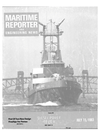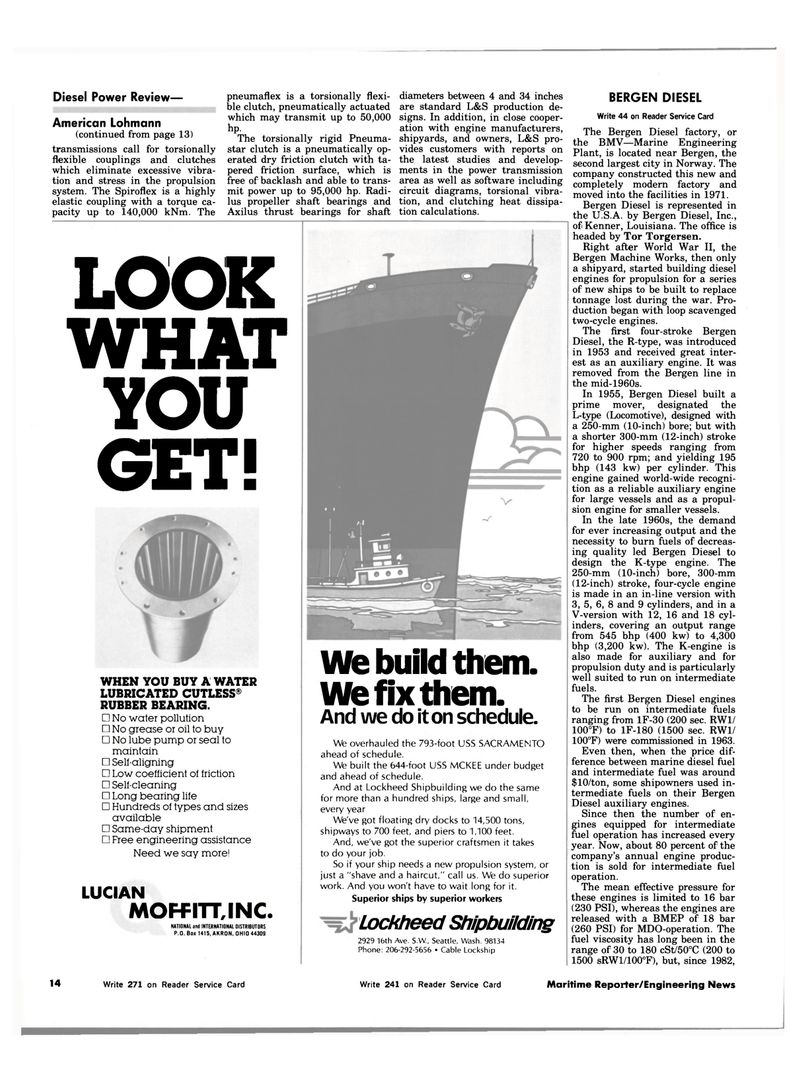
Page 10: of Maritime Reporter Magazine (July 15, 1983)
Read this page in Pdf, Flash or Html5 edition of July 15, 1983 Maritime Reporter Magazine
Diesel Power Review—
American Lohmann (continued from page 13) transmissions call for torsionally flexible couplings and clutches which eliminate excessive vibra- tion and stress in the propulsion system. The Spiroflex is a highly elastic coupling with a torque ca- pacity up to 140,000 kNm. The pneumaflex is a torsionally flexi- ble clutch, pneumatically actuated which may transmit up to 50,000 hp.
The torsionally rigid Pneuma- star clutch is a pneumatically op- erated dry friction clutch with ta- pered friction surface, which is free of backlash and able to trans- mit power up to 95,000 hp. Radi- lus propeller shaft bearings and
Axilus thrust bearings for shaft diameters between 4 and 34 inches are standard L&S production de- signs. In addition, in close cooper- ation with engine manufacturers, shipyards, and owners, L&S pro- vides customers with reports on the latest studies and develop- ments in the power transmission area as well as software including circuit diagrams, torsional vibra- tion, and clutching heat dissipa- tion calculations.
LOOK WHAT
YOU GET!
WHEN YOU BUY A WATER
LUBRICATED CUTLESS®
RUBBER BEARING. • No water pollution • No grease or oil to buy • No lube pump or seal to maintain • Selt-aligning • Low coefficient of friction • Self-cleaning • Long bearing life • Hundreds of types and sizes available • Same-day shipment • Free engineering assistance
Need we say more!
LUCIAN
MOFflTTJNC.
NATIONAL and INTERNATIONAL DISTRIBUTORS
P.O. Box 1415, AKRON. OHIO 44309
We build them.
We fix them.
And we do it on schedule.
We overhauled the 793-foot USS SACRAMENTO ahead of schedule.
We built the 644-foot USS MCKEE under budget and ahead of schedule.
And at Lockheed Shipbuilding we do the same for more than a hundred ships, large and small, every year
We've got floating dry docks to 14,500 tons, shipways to 700 feet, and piers to 1,100 feet.
And, we've got the superior craftsmen it takes to do your job.
So if your ship needs a new propulsion system, or just a "shave and a haircut," call us. We do superior work. And you won't have to wait long for it.
Superior ships by superior workers
Lockheed Shipbuilding 2929 16th Ave. S.W., Seattle, Wash. 98134
Phone: 206-292-5656 • Cable Lockship
BERGEN DIESEL
Write 44 on Reader Service Card
The Bergen Diesel factory, or the BMV—Marine Engineering
Plant, is located near Bergen, the second largest city in Norway. The company constructed this new and completely modern factory and moved into the facilities in 1971.
Bergen Diesel is represented in the U.S.A. by Bergen Diesel, Inc., of Kenner, Louisiana. The office is headed by Tor Torgersen.
Right after World War II, the
Bergen Machine Works, then only a shipyard, started building diesel engines for propulsion for a series of new ships to be built to replace tonnage lost during the war. Pro- duction began with loop scavenged two-cycle engines.
The first four-stroke Bergen
Diesel, the R-type, was introduced in 1953 and received great inter- est as an auxiliary engine. It was removed from the Bergen line in the mid-1960s.
In 1955, Bergen Diesel built a prime mover, designated the
L-type (Locomotive), designed with a 250-mm (10-inch) bore; but with a shorter 300-mm (12-inch) stroke for higher speeds ranging from 720 to 900 rpm; and yielding 195 bhp (143 kw) per cylinder. This engine gained world-wide recogni- tion as a reliable auxiliary engine for large vessels and as a propul- sion engine for smaller vessels.
In the late 1960s, the demand for ever increasing output and the necessity to burn fuels of decreas- ing quality led Bergen Diesel to design the K-type engine. The 250-mm (10-inch) bore, 300-mm (12-inch) stroke, four-cycle engine is made in an in-line version with 3, 5, 6, 8 and 9 cylinders, and in a
V-version with 12, 16 and 18 cyl- inders, covering an output range from 545 bhp (400 kw) to 4,300 bhp (3,200 kw). The K-engine is also made for auxiliary and for propulsion duty and is particularly well suited to run on intermediate fuels.
The first Bergen Diesel engines to be run on intermediate fuels ranging from 1F-30 (200 sec. RW1/ 100°F) to 1F-180 (1500 sec. RW1/ 100°F) were commissioned in 1963.
Even then, when the price dif- ference between marine diesel fuel and intermediate fuel was around $10/ton, some shipowners used in- termediate fuels on their Bergen
Diesel auxiliary engines.
Since then the number of en- gines equipped for intermediate fuel operation has increased every year. Now, about 80 percent of the company's annual engine produc- tion is sold for intermediate fuel operation.
The mean effective pressure for these engines is limited to 16 bar (230 PSI), whereas the engines are released with a BMEP of 18 bar (260 PSI) for MDO-operation. The fuel viscosity has long been in the range of 30 to 180 cSt/50°C (200 to 1500 sRWl/100°F), but, since 1982, 14 Write 271 on Reader Service Card Write 241 on Reader Service Card Maritime Reporter/Engineering News

 9
9

 11
11
